How Deep Is A Water Service Pipe
Depths of Utility Service Pipes and Cables
In this DIY guide yous volition learn about the required depths that utility supply pipes and cables such as water pipes, gas pipes and electrical supply cables need to be buried to in club to reduce the adventure of damage when excavating and digging in the footing. Also larn about how utility supplies should exist spaced and what colours utility pipes and cables need to be.
Unless you live in an off-grid property, in most cases, your home should have dedicated supplies of water, gas, electricity and telecommunications such every bit a phone line and broadband and possibly cable TV.
In some situations, utilities such as phone lines and electricity may be supplied by overhead cables but in a lot of instances they are supplied through a network of underground pipes and cables.
To ensure that any pipes or cables in the ground remain prophylactic from damage, they need to be buried at a set depth depending on the type of utility it is.
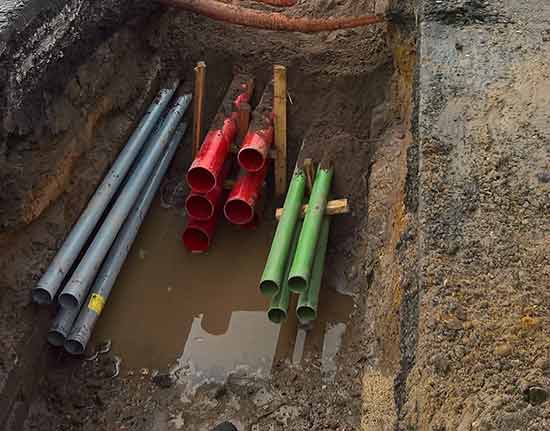
Utility supply pipes and cables buried in ground – Image courtesy of ccsbestpractice.org.united kingdom of great britain and northern ireland
What are Utilities?
Utilities are essentially necessary services that include water, electricity, gas, phone and broadband that are supplied to a belongings by a utility company so that the occupants have power for cooking, lighting, heating and running appliances and water for drinking, washing clothes and bathing etc.
Also included under the "utilities" umbrella are sewage and waste water services.
Unless yous generate your own ability for complimentary through solar panels, wind turbines or similar or have your own well or bore hole for water, all mains-supplied gas, water, on-filigree electricity or telecommunication services are charged for.
Likewise, unless you lot deal with and dispose of your own sewage and gray water, you volition also pay a utilities company to deal with your household waste.
There are quite a few different utility supply companies in the United kingdom, some supply just 1 service, while others supply several services.
For most utilities, you will pay for the amount y'all use e.yard. the volume of gas, electricity or h2o you apply over a sure period but in some cases, charges are simply a fixed monthly fee e.g. telephone and broadband or sewage.
When information technology comes to charges, in most instances you volition pay for the volume of the given service you use, plus admin and other fees added by your given utility supply company. In some cases these fees volition also include rental and upkeep of the supply network.
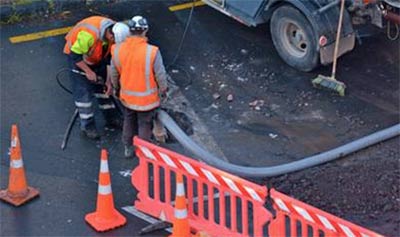
Utility supply pipes and cables demand to exist maintained and repaired
Tin I lay my ain Utility Supply Pipes and Cables?
When it comes to either gas, electricity or water, yous admittedly cannot lay your own supply pipes as there are very strict rules on the type of pipework to be used, ducting, how the trench is formed, how a given supply is continued to the mains etc defined by the HSE (Health and Safety Executive) and OFGEM.
In pretty much all cases, to ensure a given new utility supply piping or cable is installed and connected correctly, any work will need to exist carried out past a qualified engineer.
Additionally, most mains gas supply pipes, mains water supply pipes and mains electricity cables will have been run under or near public state e.g. roads, footpaths, verges etc and y'all absolutely cannot go earthworks up a public road without the right paperwork and qualifications to say that you can.
With the above in mind, if you did want to install a new gas, h2o or electrical supply the best mode to go nearly it is to contact your given supplier and arrange the works through them.
Be nether no illusions though, it'southward going to be expensive, but they will have all the necessary contractors, licenses and specialists at mitt to go the chore done quickly, safely and line with any and all relevant regulations.
As we accept stated above, digging on or around public land yourself is out of the question, but when it comes to excavation on your ain individual land, this can in some cases exist possible.
For example, if y'all were running a new gas principal to your property, information technology may be possible for you to dig the trench for the new supply line where it runs over your own private land, this tin can in some instances save you a fair clamper of money.
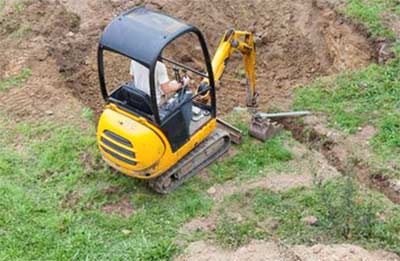
Earthworks a trench through a garden for a new utility
However, this tin can simply exist done to HSE guideline specifications and also any guidelines specified by your utility supplier.
One other pint to be aware of is that your utility supplier will too probably plan the road of the new supply line across your property for you.
It'south of import to note that in some case the utility supplier will insist that all works are carried out by their ain engineers in which case this will probably also include any digging on your ain private land.
If your supplier does agree to you carrying out any earthworks piece of work yourself, as said, specifications will be defined past them and the HSE, only in most cases, they will be similar to the following specs listed below.
How Deep Should Electrical Cables be Cached in the Footing?
When running electric cables underground, they should be buried at a depth of at least 600mm and information technology should run in a way that it avoids any potential disturbance impairment both now and in the future. Depths do vary slightly depending on the cable load and basis-type you're laying in:
| Ground Type | Cablevision Voltage and Min Depth (mm) | ||
|---|---|---|---|
| Low Voltage (LV) Cablevision | 11kv Cablevision | 33kv Cable | |
| Unmade Basis, Footpaths and Verges | 450 | 600 | g |
| Roads | 600 | 700 | 1000 |
| Gardens | 600 | 700 | 1000 |
| Agricultural Land | 1000 | 1000 | 1000 |
When burying electric cable, y'all should always use armored cable or SWA (steel wire armored cablevision) cablevision that's protected past a a steel outer coating. In the issue that a spade or other object hits the cable, the steel coating prevents it from being severed.
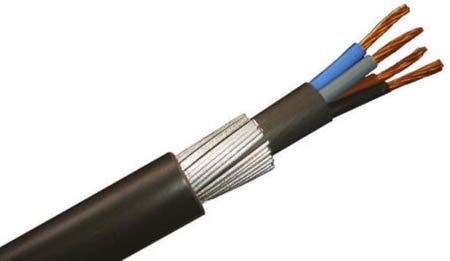
SWA armored electrical cable
The steel coating should also exist protected with a plastic or safe coating to forbid any chance of corrosion.
In terms of the potential dangers of the protective armor, whatever problems are resolved by the fact that information technology earths straight back to the lath, so in the event of any bug, the board would trip direct away.
It is possible to also utilise a non-armored cable, but when y'all practise, it should be run inside a protective conduit or duct that provides the same level of protection as the armor in an armored cable.
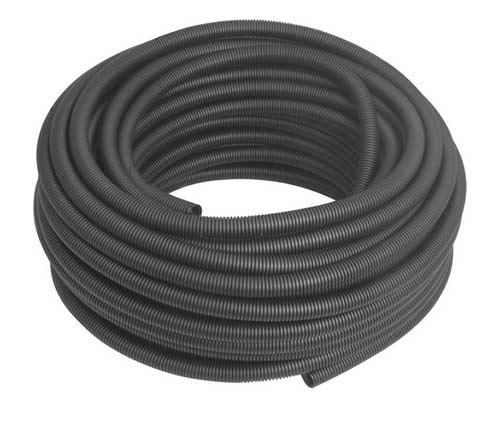
Protective conduit for electrical cable for laying in the ground
The cable itself should be laid in a trench with a smooth and flat base of operations, with no sharp objects such equally rocks, stones etc present.
The chugalug and braces arroyo when burying cable is to also encase the cablevision in 75mm of sand e.g. 75mm beneath, above and to the sides then place electrical tape or a marker 150mm above this so that anyone digging in the basis will find the warning tape and exist warned of the presence of the cable.
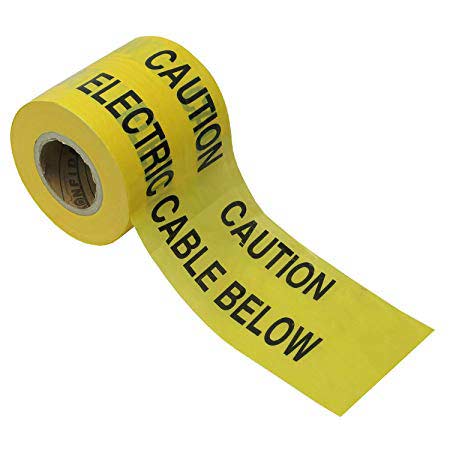
Electrical warning tape to be laid over newly installed cables to warn of their presence
To complete all of the safety aspects fully, any new hole-and-corner cables, for example, to run a new supply out to a garage outbuilding, the cached cable would exist required to run back to a 30mA RCD, so if in that location is any slight result, the RCD would then trip and cut power preventing any serious injury.
How Deep Should Gas Pipes be Buried in the Ground?
When running a gas main supply piping underground the HSE specifies it should exist at least 750mm deep in a verge or route, merely 600mm deep for a footpath. In the case of a gas service pipe, this should be a minimum of 375mm deep on individual footing and a minimum 450mm deep when laid under footpaths and roads.
| Depth (minimum) | |||
|---|---|---|---|
| Type of Piping | Verge / Route | Footpath | Private Footing |
| Gas Main Pipe | 750mm | 600mm | n/a |
| Gas Service Pipe | 450mm | 450mm | 375mm |
To explain the difference betwixt pipes a little more, the gas main pipe is the main supply pipe that runs downwards your street supplying various properties, whereas a gas supply pipe runs from the gas main, up to your holding and connects to your gas meter.
From the gas meter, supply pipework and then runs into your home to supply your various gas appliances.
All gas supply pipes must be continued to a meter. The meter not just records the volume of gas you use so you can be billed for information technology, but it too regulates the pressure level of the gas entering your property.
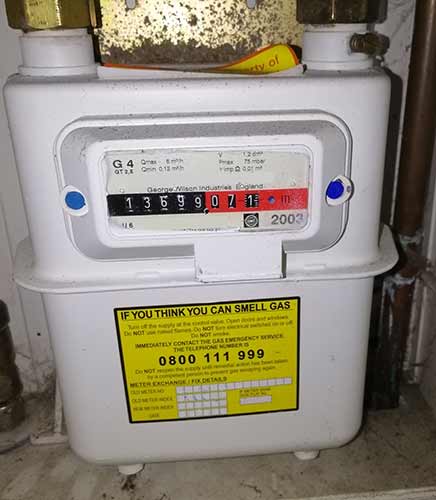
Domestic gas meter used to supply a property with gas
The pressure of gas in the mains pipework varies quite a bit depending on supply and usage and all home appliances crave a regulated supply to allow them to operate correctly and efficiently. Irregular gas pressure tin crusade appliances to become faulty and potentially cause serious injury.
Both the gas main pipe and y'all homes particular supply pipage will be managed and maintained by the National Grid or an approved gas transporter. If you lot need to know who your local gas transporter is, you lot tin download a factsheet from eth Ofgem website here.
Equally with electrical supplies, nether no circumstances are you allowed to carry out any gas connectedness work yourself! That also goes for the installation of new pipework.
The same goes for whatsoever internal gas work, this should only be carried out by a Gas Safe engineer.
Again, it may be possible to exercise any trench earthworks and preparation work yourself where new pipework is to be run over your own private country, but you volition need to discuss and agree this with the gas transporter that is performing the installation.
When it comes to the bodily pipage that is used, traditionally this would have been cast or ductile atomic number 26 but as these corrode over fourth dimension, today polyethylene tends to exist used.
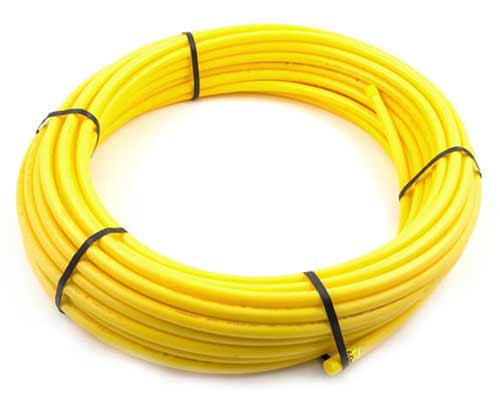
Polyethylene gas supply pipage
Gas supply and mains pipes are too normally coloured yellow to make them easily identifiable from other utility supplies.
There are as well sure specifications that the trench the pipe will be laid in has to meet.
Firstly, the trench should take a shine base, gratuitous from any sharp or jagged objects. If any are constitute, yous may exist required to dig down a further 75mm and refill with sand or a similar fine substance.
Gas supply pipes should also be laid at a slight gradient, running away from the supply destination and likewise in a straight line.
In one case the trench is prepared a layer of sand is used to line the base for the pipage to lay on. Once in place, a minimum of 100mm of sand is then placed over and effectually the pipe to encase information technology and the trench is then backfilled with soil.
At a minimum of 75mm above the pipe, warning tape is then laid along the unabridged length of the run to warn of the pipes presence.
Additionally, if any other services are to be run near the gas supply pipe then there should be a minimum of 250mm clearance between them and the gas pipe.
How Deep Should Water Pipes be Cached in the Footing?
Bluish MDPE pipe is used to supply mains water to homes and properties throughout the UK. When laying MDPE water supply pipe, it should be laid at a minimum of 750mm and a maximum of 1350mm below finished basis level.
When water supply pipage is to exist laid near to other utilities supplies such as gas or electricity, information technology should be a minimum of 350mm away.
When it comes to digging the trench itself, aside from digging it to the correct depth, it should also be cut to a minimum width of 250mm plus the external bore of the pipe itself.
| Depth (minimum) | ||||
|---|---|---|---|---|
| Blazon of Pipe | Min Depth | Max Depth | Min Gap Other Services | Trench Width |
| MDPE Water Supply Pipe | 750mm | 1350mm | 350mm | 250mm plus piping diameter |
Once the trench itself has been cut at that place are as well guideline that demand to exist followed in terms of the bed preparation earlier laying whatsoever pipe.
As with other utility supplies, the bed of the trench should be level, flat and smooth and free of any stone, rock or similar difficult, jagged objects. If this is the case, so it may be possible to lay your piping directly on the base.
If this is not the case, then the trench will demand to be excavated a further minimum of a 100mm and a bed of sharp sand laid for the piping to rest on.
Once the pipe is in identify in the trench it is then backfilled, firstly by a 100mm layer of sand to aid place the presence of the pipage and and so clean soil.
To ensure the pipage is held firmly in place, the soil is then compacted every 300mm.
Equally is required of other supply pipes, mark tape is laid over the length of the piping run at a minimum of 300mm in a higher place the pipage.
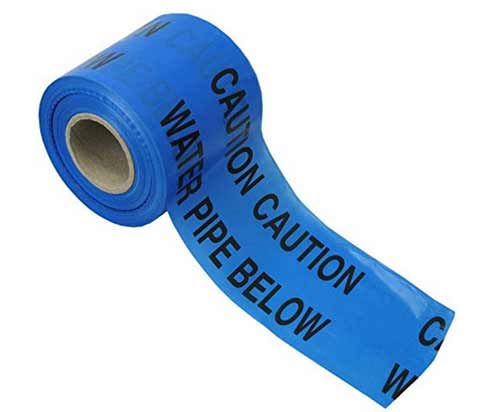
Water master mark tape to warn of presence of water main pipe
Ane terminal bespeak to mention is that where a water supply pipe is to run beneath a construction, it needs to be run through sealed ducting.
How Deep Should Telecommunications Cables exist Buried in the Ground?
In that location are several unlike types of telecoms cablevision; copper cables, fibre cablevision and cable Television cable. Copper and fibre cable should exist buried 600mm beneath a road, 350mm beneath whatsoever difficult surface and 450mm beneath a softer surface while cable Idiot box cable should be buried at a min of 250mm nether hard surfaces such as footpaths.
| Depth (minimum) | |||
|---|---|---|---|
| Blazon of Cablevision | Route | Footpaths / Hard Surfaces | Verges / Soft Footing |
| Copper Cable | 600mm | 350mm | 450mm |
| Fibre Cablevision | 600mm | 350mm | 450mm |
| Cablevision Television receiver Cable | 250mm | 250mm | 250mm |
As with other utility cables and pipes, whatever copper, fibre of cable TV cables should be run in every bit straight a line as possible with the minimum of bends.
Some other of import point to note is that when telecoms cables enter a property they should be laid at a depth of 450mm.
In line with other utilities, any and all cabling and work should be carried out past or through your telecoms provider due east.g. if y'all wanted a new phone line installed, you lot would need to contact your telephone provider and they would either conduct out the line install for you or contract it out to another company, usually Openreach in the UK.
Any and all cabling will demand to be installed in ducting. The ducting itself must also feature a draw rope so that new cables tin hands exist fatigued through. Once the cabling is in place the ducting is so capped and sealed to preclude.
Sealing the ducting is of extreme importance. As the duct essentially runs a given supply cablevision into a property, if hazardous gasses get into the duct then if its non sealed then they could possible leak into the interior the property.
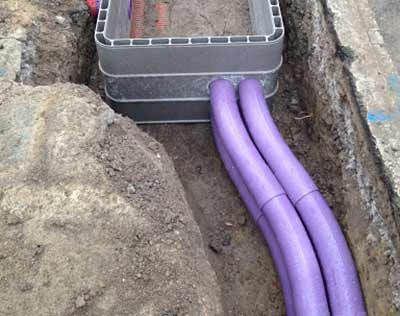
Telecoms cable ducting in trench – Epitome courtesy of pipelineutilities.co.uk
How Deep Should Sewage and Surface Water Drainage Pipes be Buried in the Ground?
In general there aren't whatever specific depth specifications for sewage and drainage pipework, in many ways the required gradient of i:40 to 1:fourscore for foul water drainage and 1:100 for surface water drainage and the sewer you're connecting to volition dictate the depth that any pipes are run.
However, the Edifice Regulations Part H document states that plastic drainage pipes should be a minimum of 600mm below gardens and fields and 900mm beneath roads and driveways.
When clay pipes are used, these should exist a minimum of 600mm beneath ground level when laid in gardens or fields and a minimum of 1200mm beneath roads and driveways.
| Depth (minimum) | |||
|---|---|---|---|
| Surface Water Drainage | Garden / Fields | Roads / Driveways | Gradient Fall |
| Plastic Piping | 600mm | 900mm | 1:100 |
| Dirt Pipe | 600mm | 1200mm | one:100 |
| Depth (minimum) | |||
|---|---|---|---|
| Foul Water Drainage | Garden / Fields | Roads / Driveways | Slope Fall |
| Plastic Piping | 600mm | 900mm | i:40 – ane:fourscore |
| Clay Pipage | 600mm | 1200mm | 1:40 – 1:80 |
In the example that the required minimum depth cannot be achieved then the pipework itself may demand to be encased in concrete to ensure it has acceptable back up. This is peculiarly of import where pipework runs under a roadway or driveway.
In terms of the trench width, this is commonly stated as being effectually 300mm plus the width of the pipe being used.
As with other utilities, any drainage pipework should exist run in a straight line and avoid any obstacles or potential dangers. Where a bend is required of more than 22.5° you lot will demand to provide access via a man hole.
Under normal circumstances, UPVC pipework should be laid in the trench on a bed of aggregate of a compatible size, with particles being no bigger than 10mm in size. However, if using dirt pipes you will need to refer to the manufacturers for their recommendations.
Pretty much any and all drainage work is notifiable work eastward.g. your local building control function will need to be informed of the work. If you have whatsoever questions regarding pipage or trench specifications and then you should enquire them and they should be able to advise.
When discussing anything to do with drainage it'south important that the correct terminology is used for the particular type of drain in question:
- Surface Water Drainage and Sewers: This type of drainage is responsible for removing rainwater from a surface. Above ground surface water drainage refers to mainly roof drainage e.g. gutters and downpipes where equally underground surface water drainage refers to the underground or sewer that carries the water abroad
- Foul Drainage and Sewers: This type of drain removes foul water from sinks, basins, baths, toilets etc. The above ground internal part of the drainage is referred to as sanitary waste pipework, whereas the below basis drainage that removes the waste material is referred to as a foul bleed or sewer
At that place is a distinct difference between a drain and sewer. In general, a bleed refers to the drainage for an private property and a sewer would generally service several or more backdrop.
A distinction should besides exist made in terms of ownership – when reference is fabricated to a private drain or sewer, the ownership will fall under the property owner, whereas a public drain or sewer will fall under the ownership of the "sewerage undertaker".
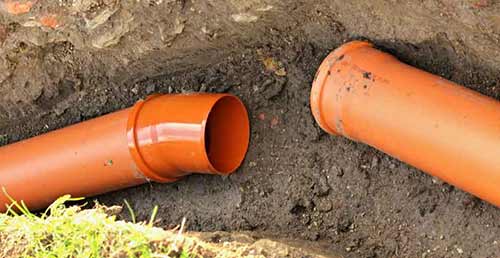
Mains sewage pipework providing mains drainage for several domestic properties – Image courtesy of expressdrainagesolutions.co.uk
If you would like to find out more about the different types of drainage see our foul and surface water drainage projection hither and for information on how to lay underground drainage see our projection here.
Safe Considerations When Digging Effectually Underground Services
Before any digging or excavation work gets underway, certain plans and guidelines accept to be put in place and adhered to.
Damaging whatsoever cloak-and-dagger supply pipe or cablevision tin can be a nightmare at best, at worst, it can be potentially lethal especially in the instance of electrical or gas mains.
A given underground service supply pipage or cablevision essentially belongs to the provider that owns or manages a given supply network and a requirement in terms of their ownership is to continue records or where all pipes and cables run.
If you are embarking on a project that involves excavating the basis then you should firstly contact any relevant service operators and ask and so for the pipage/cable plans for the area you're digging in. This should highlight the route the given service is running forth in the area you're working in.
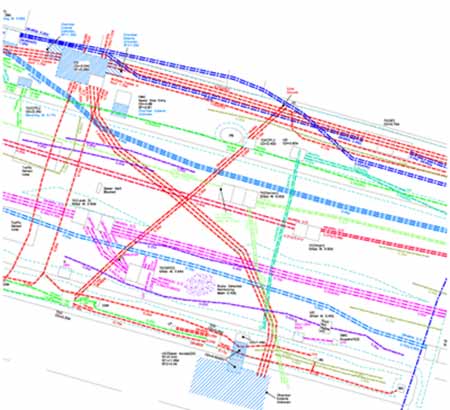
Utility pipe and cable plans available from utility suppliers
Another skilful indicator, especially with drainage is to follow the route of man hole covers. Drainage runs should run in a straight line from homo hole to man hole and past lifting the homo hole embrace itself, you should then meet any direction changes and the direction the pipage runs from that point.
If you suspect that certain supply pipes or cables are running in the expanse y'all're working in but you are unable to locate them y'all volition need to use a cable or pipe locating device or service to pinpoint their exact location.
It is possible to hire cable/pipe locators and perform this work yourself or contract in a 3rd political party company to exercise the piece of work for yous.
If yous are planning to practise this yourself, be enlightened that not all detecting devices actually detect all the different individual service that may be present in the ground. Make sure the auto or service yous apply accounts for all types of services.
Once whatever and all services take been located in the basis, their entire route should and so be marked using markers or paint of a specific colour for the service it's marking. The colours that are used should follow those stated in the National Colour Coding System for underground services.
Once any present services have been marked and identified, safe digging tin usually commence.
Earthworks in and effectually any utility supply is risky and potentially unsafe if not done correctly. For total information and guidelines, see the Health and Safety Executive Document HSG47 here. It provides full details on everything you need to know.
Note: One very of import betoken to note is that regardless of where a given plan or marker states that a particular service is cached at a certain depth this is not e'er the instance!
In the past, nosotros've constitute gas mains and electric cables buried in the ground just a few inches, so just considering an official certificate states that a given gas main should be buried at least 600mm down on the site you're working on, don't assume this is true!
What to practise if Underground Services go Damaged?
Lets face it, even if you accept every precaution and follow every guideline to the letter, accidents do happen and as we have stated above, pipes and cables aren't e'er where they are stated they should be.
In the event that an underground service supply pipe or cablevision gets damaged:
- If whatever casualties, leave them where they are unless they are in firsthand danger
- Call relevant emergency services, burn down, ambulance, police etc
- Ensure any bystanders are moved well clear to forbid injury
- Call the service owner or operator and inform them of the impairment
- Cordon off the area with barriers, tape or other means of alert
- Warn whatever nearby properties or houses of the damage
- Practise non attempt to make any repairs to the damaged pipe or cable
If you are dealing with a damaged gas main you will demand to phone call the national emergency gas line on: 0800 111 999. Ensure that no one is smoking and that there are no naked flames
Warn whatsoever nearby properties not to employ their gas services. In some cases, this can cause pressure issues within properties or gas in the air can leak into a given property.
In the upshot that an electric primary cable has been damaged, do not endeavour to remove severed cables from whatever machinery. If an excavator/digger severed the cablevision, ensure the driver/operator does not leave the machine until the cable has been isolated and is no longer live.
Even if the supply in question does not await damaged, y'all should always report a service strike to its possessor/operator.
Although water may seem fairly harmless, nether high pressure such equally that in a mains water piping (force per unit area = 1 bar or 15psi) it tin be lethal so treat it equally such.
Working in and effectually services and utility supply pipes and cables can exist a minefield of issues, but as long equally you lot have the necessary precautions and follow all relevant guidelines then any work can be carried out safely and efficiently.
How Deep Is A Water Service Pipe,
Source: https://www.diydoctor.org.uk/projects/utility-depths.htm
Posted by: arnoldexperwas89.blogspot.com


0 Response to "How Deep Is A Water Service Pipe"
Post a Comment